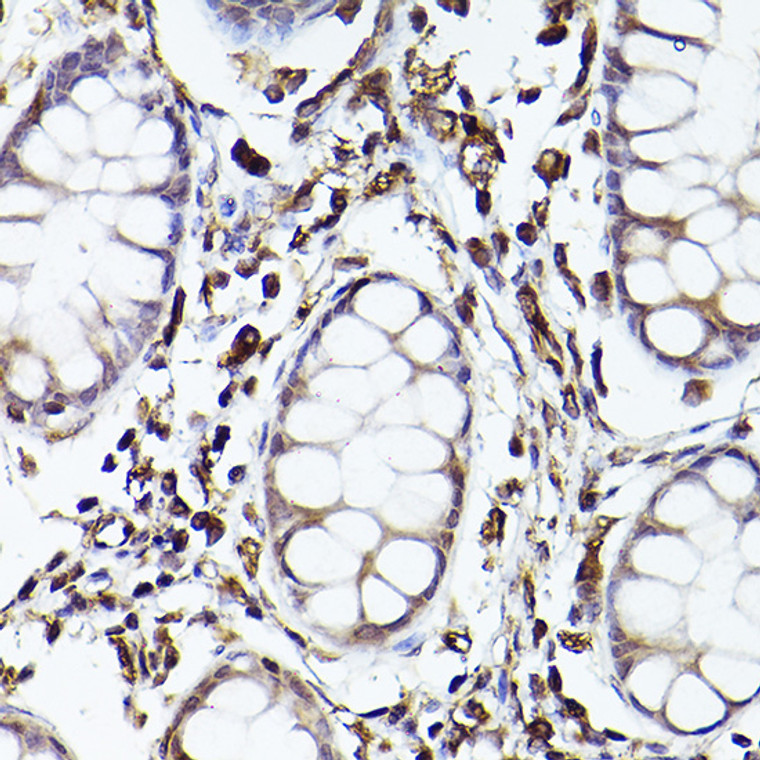| Host: |
Rabbit |
| Applications: |
WB/IHC/IF |
| Reactivity: |
Human/Mouse/Rat |
| Note: |
STRICTLY FOR FURTHER SCIENTIFIC RESEARCH USE ONLY (RUO). MUST NOT TO BE USED IN DIAGNOSTIC OR THERAPEUTIC APPLICATIONS. |
| Short Description: |
Rabbit polyclonal antibody anti-TLR8 (849-1041) is suitable for use in Western Blot, Immunohistochemistry and Immunofluorescence research applications. |
| Clonality: |
Polyclonal |
| Conjugation: |
Unconjugated |
| Isotype: |
IgG |
| Formulation: |
PBS with 0.01% Thimerosal, 50% Glycerol, pH7.3. |
| Purification: |
Affinity purification |
| Dilution Range: |
WB 1:500-1:1000IHC-P 1:50-1:200IF/ICC 1:50-1:200 |
| Storage Instruction: |
Store at-20°C for up to 1 year from the date of receipt, and avoid repeat freeze-thaw cycles. |
| Gene Symbol: |
TLR8 |
| Gene ID: |
51311 |
| Uniprot ID: |
TLR8_HUMAN |
| Immunogen Region: |
849-1041 |
| Immunogen: |
Recombinant fusion protein containing a sequence corresponding to amino acids 849-1041 of human TLR8 (NP_619542.1). |
| Immunogen Sequence: |
HHLFYWDVWFIYNVCLAKVK GYRSLSTSQTFYDAYISYDT KDASVTDWVINELRYHLEES RDKNVLLCLEERDWDPGLAI IDNLMQSINQSKKTVFVLTK KYAKSWNFKTAFYLALQRLM DENMDVIIFILLEPVLQHSQ YLRLRQRICKSSILQWPDNP KAEGLFWQTLRNVVLTENDS RYNNMYVDSIKQY |
| Tissue Specificity | Expressed in myeloid dendritic cells, monocytes, and monocyte-derived dendritic cells. |
| Post Translational Modifications | Ubiquitinated by RNF216.leading to degradation by the proteasome. Proteolytic processing occurs in monocytes and monocyte-derived macrophages by both furin-like proprotein convertase and cathepsins. The cleavage is necessary for dimer formation and subsequent activation. |
| Function | Endosomal receptor that plays a key role in innate and adaptive immunity. Controls host immune response against pathogens through recognition of RNA degradation products specific to microorganisms that are initially processed by RNASET2. Recognizes GU-rich single-stranded RNA (GU-rich RNA) derived from SARS-CoV-2, SARS-CoV-1 and HIV-1 viruses. Upon binding to agonists, undergoes dimerization that brings TIR domains from the two molecules into direct contact, leading to the recruitment of TIR-containing downstream adapter MYD88 through homotypic interaction. In turn, the Myddosome signaling complex is formed involving IRAK4, IRAK1, TRAF6, TRAF3 leading to activation of downstream transcription factors NF-kappa-B and IRF7 to induce pro-inflammatory cytokines and interferons, respectively. |
| Protein Name | Toll-Like Receptor 8Cd Antigen Cd288 |
| Database Links | Reactome: R-HSA-1679131Reactome: R-HSA-168181Reactome: R-HSA-9705671 |
| Cellular Localisation | Endosome MembraneSingle-Pass Type I Membrane ProteinEndosomal Localization Confers Distinctive Proteolytic Processing |
| Alternative Antibody Names | Anti-Toll-Like Receptor 8 antibodyAnti-Cd Antigen Cd288 antibodyAnti-TLR8 antibodyAnti-UNQ249 antibodyAnti-PRO286 antibody |
Information sourced from Uniprot.org
12 months for antibodies. 6 months for ELISA Kits. Please see website T&Cs for further guidance










